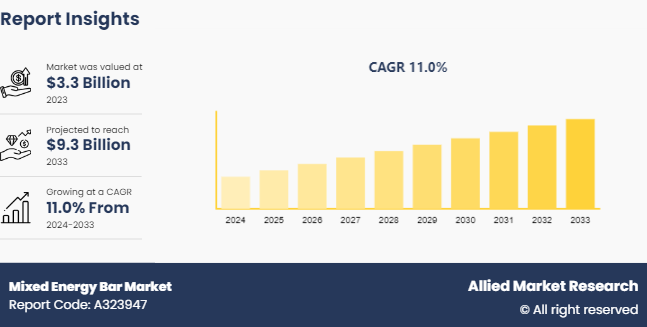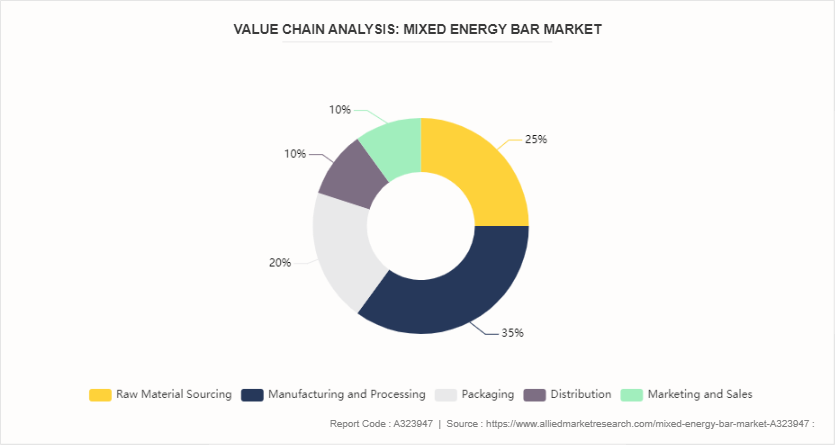Mixed Energy Bar Market Research, 2033
Market Introduction and Definition
The global mixed energy bar market was valued at $3.3 billion in 2023, and is projected to reach $9.3 billion by 2033, growing at a CAGR of 11% from 2024 to 2033. A mixed energy bar is a type of nutritional bar that mixes many critical components to deliver a well-balanced combination of macronutrients such as proteins, carbs, and fats, as well as vital vitamins, minerals, and, in some cases, dietary fiber. These bars are intended to fulfill a range of functions, ranging from delivering immediate energy boosts and improving workout performance to functioning as practical meal replacements or nutritious snacks. Mixed energy bars appeal to a wide range of people, including athletes, fitness enthusiasts, busy professionals, and health-conscious shoppers searching for accessible and healthy food alternatives.
The growing consumer awareness of health and well-being, together with the desire for quick and nutritious on-the-go snacks, has greatly increased the appeal of mixed energy bars. The rising trend of active and healthy lives, particularly among millennials and Generation Z, is accelerating mixed energy bar market size. Furthermore, the growing demand for clean-label goods including natural, organic, and non-GMO ingredients is impacting the development and innovation of products in the mixed energy bar category.

Key Takeaways
The mixed energy bar market study covers 20 countries. The research includes a segment analysis of each country in terms of value ($Billion) for the projected period 2024-2033.
More than 1, 500 product literatures, industry releases, annual reports, and other such documents of major mixed energy bar industry participants along with authentic industry journals, trade associations' releases, and government websites have been reviewed for generating high-value industry insights.
The study integrated high-quality data, professional opinions and analysis, and critical independent perspectives. The research approach is intended to provide a balanced view of global markets and to assist stakeholders in making educated decisions in order to achieve their most ambitious growth objectives.
Key market dynamics
Rising health consciousness is a significant driver of growth in the mixed energy bar market, as consumers increasingly prioritize nutrition and wellness in their daily lives. With a growing awareness of the importance of balanced diets and the benefits of functional foods, more individuals are seeking convenient, nutrient-dense options like mixed energy bars that can support their health goals. These bars offer a balanced combination of proteins, carbohydrates, and healthy fats, making them an attractive choice for those looking to maintain energy levels, manage weight, or enhance athletic performance. As health trends continue to evolve, the demand for clean-label, natural, and organic ingredients in these products is further propelling market growth.
Consumer skepticism over health claims is hindering the growth of the mixed energy bar market as increasingly savvy buyers scrutinize product labels and marketing promises. Many consumers are becoming wary of bars that tout exaggerated or unclear health benefits, especially those that contain artificial ingredients, high sugar levels, or are perceived as overly processed. This growing distrust can lead to reluctance to purchase these products, particularly among health-conscious individuals who prioritize transparency and authenticity in their food choices. As a result, brands in the mixed energy bar market must work harder to build trust through clear, honest labeling and the use of natural, high-quality ingredients to regain consumer confidence and drive growth.
Sustainability and clean labeling are creating significant growth opportunities in the mixed energy bar market as consumers increasingly prioritize environmentally friendly and health-conscious products. Brands that focus on sustainable sourcing, eco-friendly packaging, and transparent ingredient lists are appealing to a growing segment of consumers who value ethical and responsible consumption. Clean labeling, which emphasizes natural, organic, and non-GMO ingredients, resonates strongly with health-conscious buyers seeking trustworthy and wholesome options. By aligning with these values, companies can differentiate themselves in a crowded market, attract a loyal customer base, and capitalize on the rising demand for products that contribute to both personal well-being and environmental stewardship.
Value Chain Market Analysis of Global Mixed Energy Bar Market
Raw Material Sourcing:
The first stage in the mixed energy bar market value chain involves sourcing raw materials, including proteins (e.g., whey, soy, plant-based) , carbohydrates (e.g., oats, grains) , fats (e.g., nuts, seeds) , sweeteners (e.g., honey, agave) , and other functional ingredients like vitamins, minerals, and superfoods. The quality and sustainability of these ingredients are crucial, as they directly impact the nutritional value, taste, and market appeal of the final product.
Manufacturing and Processing:
In this stage, the raw materials are processed and transformed into mixed energy bars. This involves blending, mixing, shaping, and baking or extruding the bars, followed by coating or adding inclusions like chocolate chips or fruit pieces. Quality control is essential to ensure consistency in taste, texture, and nutritional content.
Packaging:
Packaging plays a dual role in both protecting the product and appealing to consumers. Mixed energy bars are typically packaged in single-serving wrappers or multi-packs, with a growing emphasis on sustainable, recyclable, or biodegradable materials to reduce environmental impact. The packaging also serves as a marketing tool, conveying key information such as nutritional benefits, clean labeling claims (e.g., organic, gluten-free) , and branding elements that attract health-conscious buyers.
Distribution:
The distribution stage involves the logistics of getting mixed energy bars from manufacturers to various retail channels, including supermarkets, convenience stores, specialty health stores, and online platforms. Efficient distribution networks are vital to ensuring product availability and freshness, especially given the often limited shelf life of natural and organic products.
Marketing and Sales:
Marketing and sales efforts are crucial in driving consumer awareness and demand for mixed energy bars. This stage involves developing and executing strategies that highlight the product’s health benefits, clean labeling, sustainability credentials, and taste appeal. Brands use various channels, including social media, influencer partnerships, in-store promotions, and online advertising, to reach target audiences.

Market Segmentation
The mixed energy bar market is segmented into ingredient type, nature, distribution channel, and region. On the basis of ingredient type, the market is divided into plant-based and animal-based. As per nature, the market is segregated into organic and conventional. Based on the distribution channel, the market is divided into supermarkets/hypermarkets, drug stores & pharmacies, convenience stores, online, and others . Region wise, the market is analyzed across North America, Europe, Asia-Pacific, and LAMEA.
Regional/Country Market Outlook
In North America, the market is driven by a strong focus on health and fitness, with increasing consumer demand for high-protein, low-sugar, and clean-label products. The proliferation of fitness and wellness trends, coupled with a growing emphasis on convenient, on-the-go nutrition, is fueling market growth. Key opportunities lie in product innovation, such as the introduction of new flavors and functional ingredients, and the expansion of direct-to-consumer sales channels.
In Europe, sustainability and clean labeling are major trends shaping the market. Consumers are increasingly seeking energy bars made from organic, non-GMO, and ethically sourced ingredients. The growth is supported by a rising awareness of environmental issues and a preference for healthier, transparent food options. Opportunities in Europe include catering to niche markets with specialized dietary needs, such as gluten-free or vegan bars, and leveraging eco-friendly packaging solutions to appeal to environmentally conscious buyers.
In the Asia-Pacific region, rapid urbanization, rising disposable incomes, and a growing focus on health and wellness are driving the demand for mixed energy bars. The market is characterized by a rising middle class with increasing awareness of nutrition and fitness, leading to a greater demand for convenient and nutritious snack options. Growth opportunities include tapping into the burgeoning health-conscious consumer base, adapting products to local tastes and dietary preferences, and expanding distribution networks to reach emerging markets with evolving health trends.
Industry Trends:
Demand for accessible, on-the-go nutrition solutions is increasing, driven by hectic lives and a need for quick, healthy alternatives. Mixed energy bars are gaining popularity among customers who want a healthy meal but have limited time.
Consumers have a significant preference for protein-rich, low-sugar mixed energy bars, which coincide with health and fitness trends. Consumers are seeking items that deliver long-lasting energy without extra sugars.
Consumers are increasingly looking for clarity in the contents used in mixed energy bars, choosing goods with simple labelling that include only recognizable substances. This trend is part of a larger push towards better eating.
Competitive Landscape
The major players operating in the market competing for the mixed energy bar market share include Mars, Incorporated., PROBAR LLC, McKee Foods Corporation, THG plc, The Simply Good Foods Company, General Mills Inc., BellRing Brands, Inc, NuGo Nutrition, Inc., Mondelez International, Inc., and Kellogg Company
Recent Key Strategies and Developments
In 2020, Nestle S.A. launched the 'Yes! Plant Protein Bars, which contain nuts and peas. This launch aims to give customers a healthy meal alternative full of important nutrients, demonstrating Nestle's dedication to nutritional innovation and fulfilling changing consumer expectations in the mixed energy bar market forecast period.
In 2022, Glanbia Nutritionals developed unique solutions for protein for extruded snacks, cereals, and inclusions based on generations of experience in protein and bar formulations.
February 2021, Veji Holdings, located in the U.S., has developed plant-based mixed energy bar aimed at patients and athletes. The firm stated that all of its nutritious products are gluten-free, vegan, non-GMO, and designed to fulfill Health Canada standards.
Key Benefits For Stakeholders
- This report provides a quantitative analysis of the market segments, current trends, estimations, and dynamics of the mixed energy bar market analysis from 2024 to 2033 to identify the prevailing mixed energy bar market opportunities.
- The market research is offered along with information related to key drivers, restraints, and opportunities.
- Porter's five forces analysis highlights the potency of buyers and suppliers to enable stakeholders make profit-oriented business decisions and strengthen their supplier-buyer network.
- In-depth analysis of the mixed energy bar market segmentation assists to determine the prevailing market opportunities.
- Major countries in each region are mapped according to their revenue contribution to the global market.
- Market player positioning facilitates benchmarking and provides a clear understanding of the present position of the market players.
- The report includes the analysis of the regional as well as global mixed energy bar market trends, key players, market segments, application areas, and mixed energy bar market growth strategies.
Mixed Energy Bar Market Report Highlights
| Aspects | Details |
| Market Size By 2033 | USD 9.3 Billion |
| Growth Rate | CAGR of 11% |
| Forecast period | 2024 - 2033 |
| Report Pages | 235 |
| By Ingredient Type |
|
| By Nature |
|
| By Distribution Channel |
|
| By Region |
|
| Key Market Players | BellRing Brands, Inc, PROBAR LLC, MONDELEZ INTERNATIONAL, INC, The Simply Good Foods Company, NuGo Nutrition, Inc., McKee Foods Corporation, General Mills Inc., Mars, Incorporated., THG plc, Kellogg Company |
The global mixed energy bar market was valued at $3.3 billion in 2023, and is projected to reach $9.3 billion by 2033, growing at a CAGR of 11.0% from 2024 to 2033.
The mixed energy bar market registered a CAGR of 11.0% from 2024 to 2033.
The forecast period in the mixed energy bar market report is from 2024 to 2033.
The top companies that hold the market share in the mixed energy bar market include Mars, Incorporated., PROBAR LLC, McKee Foods Corporation, THG plc, The Simply Good Foods Company, General Mills Inc., and others.
The mixed energy bar market report has 3 segments. The segments are ingredient type, nature, and distribution channel.
Loading Table Of Content...


